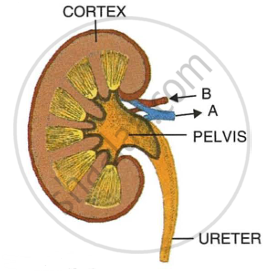Advertisements
Advertisements
प्रश्न
Explain the Term: Ureter
उत्तर
Ureter: From the hilum of a kidney, arises a narrow tube which carries the urine collected in the pelvis of the kidney to the urinary bladder which is situated at the base of the abdomen.
APPEARS IN
संबंधित प्रश्न
The given diagram represents a nephron and its blood supply. Study the diagram and answer the following questions:

(i) Label parts 1, 2, 3 and 4.
(ii) State the reason for the high hydrostatic pressure in the glomerulus.
(iii) Name the blood vessel which contains the least amount of urea in this diagram.
(iv) Name the two main stages of urine formation.
(v) Name the part of the nephron which lies in the renal medulla.
What job is done by the kidneys?
In which of the following are the largest amounts of nitrogen excreted from a mammalian body?
(a) breath
(b) sweat
(c) urine
(d) faeces
Differentiate between
excretion and transpiration
Define the following term:
Osmoregulation
Given below is a simplified diagram of the human kidney cut open longitudinally. Answer the questions that follow.
 |
- Define excretion.
- Why does the cortex of the kidney show a dotted appearance?
- Why does the medulla of the kidney show a striped appearance?
- Write two differences in the composition of the blood flowing through the blood vessels 'A' and 'B'.
Choose the correct answer:
Narrow apex of pyramid in kidney is called ___________
Give Technical Term:
The duct which transports urine from the kidney to the urinary bladder.
Answer the following question.
Name any one guanotelic organism.
Given below is a list of substances - select the ones that need to be eliminated from the body.
Glucose, excess water, amino acids, urea, carbon dioxide, excess common salt, glycogen, uric acid.
